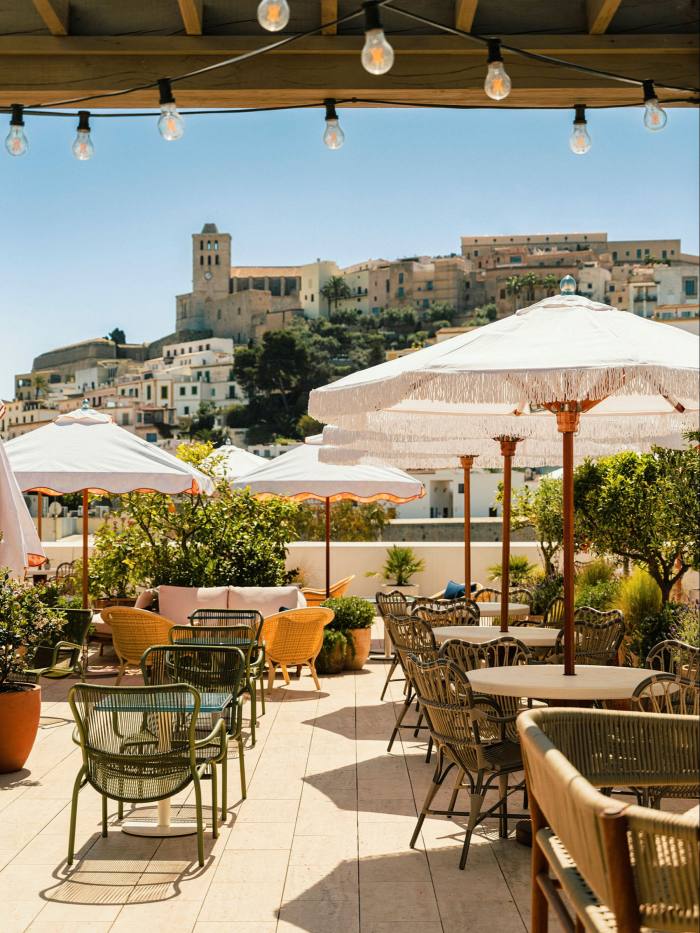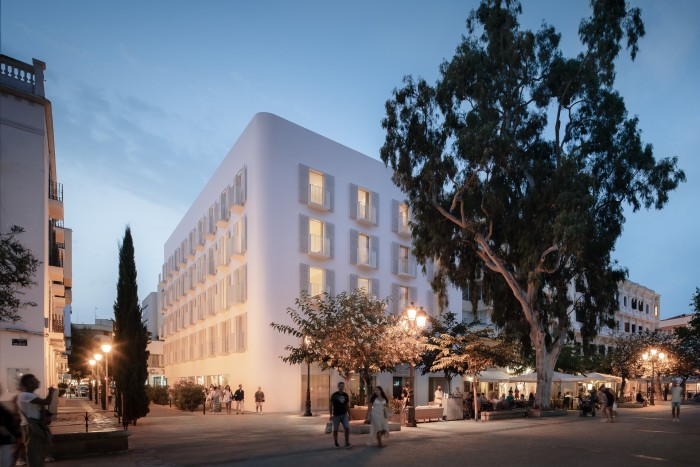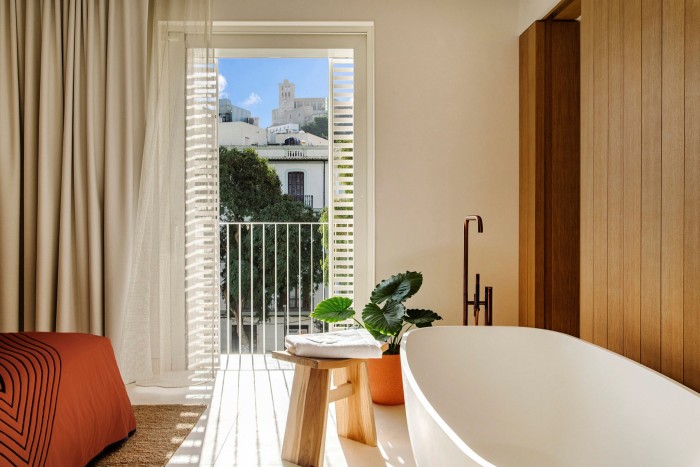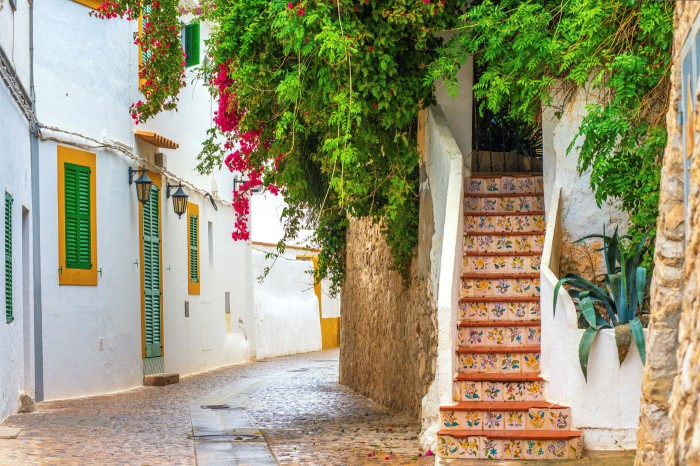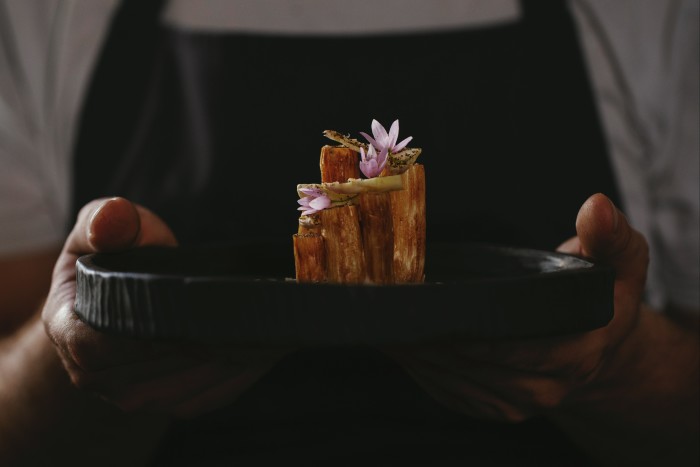Gingerly I descended into the cave-like crypt of the Phoenician necropolis, my eyes adjusting to the gloom. A skull grinned at me from a stone sarcophagus. It wasn’t what you might call a standard Ibiza experience but then neither were the day’s other highlights — the abstract expressionist painting in the contemporary art museum, dinner at the restaurant whose Danish chef had worked at Noma, or the stroll back to the townhouse hotel through whitewashed, moonlit streets.
Like it or not, what Brand Ibiza represents to most people is debauchery and dancing. What you’re least likely to associate with this Balearic isle is high culture, gastronomy and historic architecture. Yet a chic new hotel in the heart of town has opened the door to a new kind of Ibiza holiday providing all of the latter and none of the former: the relaxed, grown-up, culture-focused city break.
Following a short-hop flight from Valencia (so very short the “fasten seatbelt” signs had barely gone off before the captain was announcing our descent) I rolled smugly into town in a chauffeur-driven all-electric Mercedes EQC (included in the hotel’s room rates). To right and left were the season’s first crop of freshly pasted club billboards, though disco madness wouldn’t be on my menu this weekend. Up ahead was the skyline familiar to anyone who has ever set foot on this island: a little hill rising prettily above the Mediterranean sea, crowned with a mighty castle and the flat-sided bell-tower of a 14th-century cathedral.
Known by outsiders as Ibiza Town and by locals simply as Vila (“town”), the island’s capital has long been overlooked by visitors in favour of the hippy-glam villages of the interior and the seaside tourist towns. Parking was a nightmare and accommodation options were severely limited.
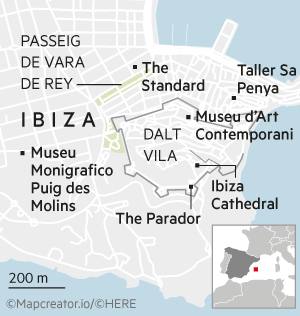
Recent years have seen several upscale hotels appearing on the outskirts (Nobu in Talamanca bay, Sir Joan on Botafoch harbour) but downtown there’s been little of note until now. At the very top of Dalt Vila (“upper town”) the new Parador — finally slated to open next year after almost two decades of stop-start building work — may well prove to be a game-changer for Ibiza’s kasbah-like medieval nucleus. In spring next year the Experimental Group is due to relaunch the venerable 1930s Gran Hotel Montesol after revamping its bedrooms. But the big news this summer is an outpost of the New York-based Standard group, only its second in Europe after launching in London in 2019. The new 53-room hotel, an all-white modernist structure whose balconies subtly mimic those of an old-fashioned Spanish apartment house, stands directly on Passeig Vara de Rey, traditionally the solar plexus of social life in the town.
In the cool of the morning I stood on the balcony of my second-floor room to survey the Passeig, an elegant promenade like a miniature version of Barcelona’s Las Ramblas, with tables set out under the oleander and eucalyptus trees. Newly cleared of traffic, the Passeig had the pleasantly somnolent vibe of the provincial Spanish town that essentially Vila has always been. At this hour of the day, with the clubbers and cruise-ship passengers still snoring in their beds, its denizens were mainly locals going about their business between banks, estate agents and lawyers’ offices, while a gaggle of girls in pleated skirts made their way to school.
The memories came trickling back. On the site of this new hotel there used to be an old flea-pit, the Cine Serra, where on a winter night in 1989 I once saw The NeverEnding Story dubbed into Spanish. The projectionist got the reels mixed up, rendering the plot incomprehensible.
It may be just coincidence but there’s something almost cinematic about the Standard. The Jara restaurant and coctelería, open to the street, has more than a touch of movie glamour, with dining chairs in white lacquer and olive-green velvet and shallow ceiling domes lit with a soft orange glow. The hotel’s interior design by Verena Haller and Lázaro Rosa-Violán playfully references the goofy, gaudy aesthetic that Ibiza has made its own: beside the lifts a giant yellow hand raises a finger to the heavens.
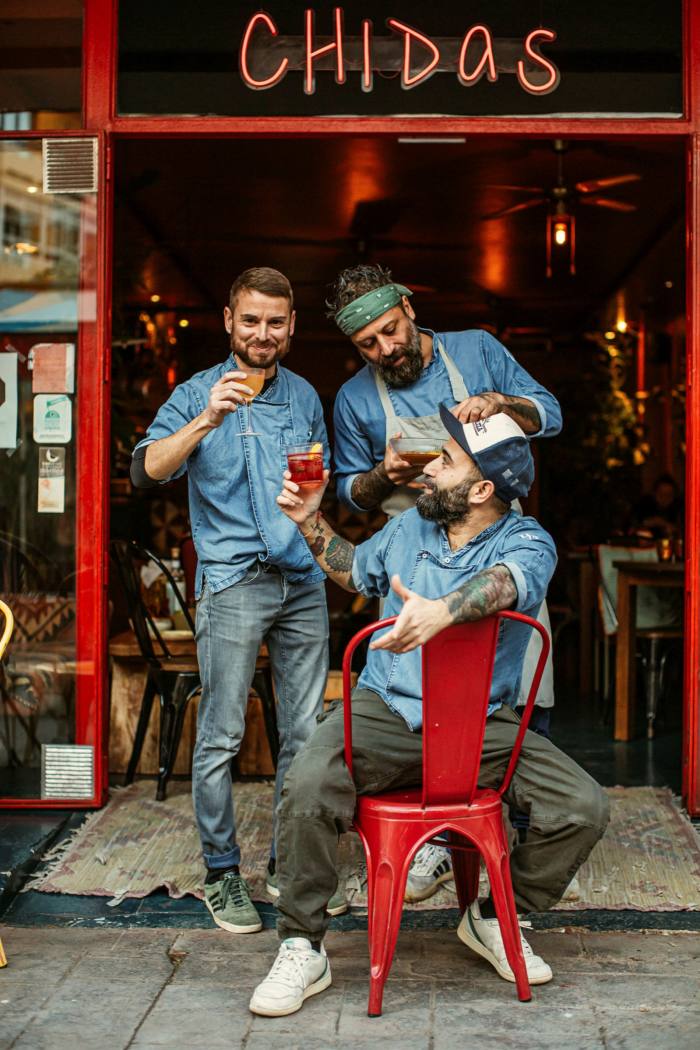
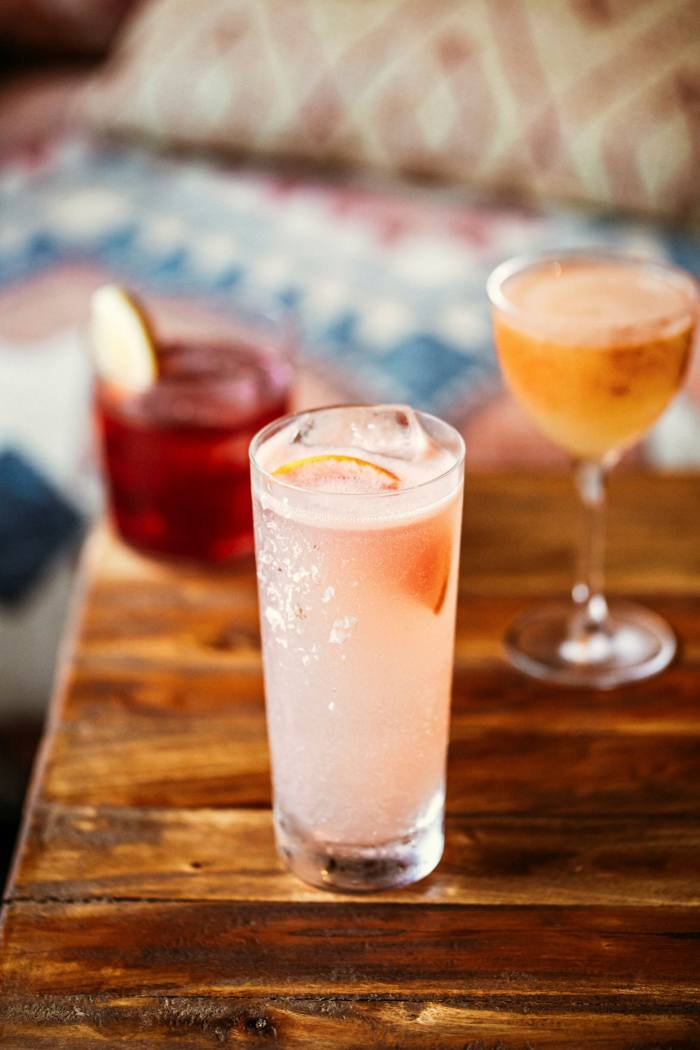
The weekend’s agenda coalesced into something like a plan. There would be shopping among the funky boutiques close to the harbour, visits to museums, and gentle walks around the narrow streets. I’d taken the precaution of calling up Serena Cook, founder of the concierge and events company Deliciously Sorted Ibiza, for her hot tips around town. These ranged from the classic Comidas Bar San Juan, a been-there-forever eating house in La Marina neighbourhood with homely Spanish fare served on marble-topped tables, to modern gastrobars (Re-Art, Chidas cantina) and Boris Buono’s extraordinary Taller Sa Penya, set in a townhouse just below the bastion of Santa Llúcia.
Beyond the airport transfers I wouldn’t be needing a car, as everything of interest lay within easy walking distance — even the seaside. One day I bought slices of coca (the savoury tart that is Spain’s own take on the pizza) at an old-town bakery and trekked round the base of the castle walls to a secret cove where the calm blue water made for a refreshing dip before my simple picnic.
From the Passeig I made my way through La Marina and up the stone ramp into the Dalt Vila, recognised by Unesco’s World Heritage scheme for the way it preserves the imprints of successive cultures, from the Phoenician and Arab periods onwards. The city’s massive Renaissance fortifications, masterminded by Italian fort-builder Giovanni Battista Calvi under the orders of King Philip II, tower over the harbour like artificial cliffs, while immured within them lies Dalt Vila’s maze of cobbled alleyways.
A murmur of chanting voices emerged from the church of Saint Augustine: the nuns of the nearby convent at their morning prayer. There were aristocratic mansions with Gothic windows and patios where giant ferns stood in terracotta pots, and long spooky tunnels leading deep into the battlements only to emerge into the dazzling sun beyond the wall. The winding streets of white-painted houses with washing fluttering from their balconies brought echoes of Cádiz’s Moorish “pueblos blancos” or the Albaicín neighbourhood of Granada.
At the summit of the town was the cathedral, built in the 14th century and restored in the 18th. From this vantage point the city seemed to tumble down headlong towards the harbour, Formentera a grey shape on the near horizon. The castle, soon to become the newest of Spain’s state-run Paradors after 18 years in the making and a spend of €27mn, is in reality a complex fusion of various distinct buildings — including an Arab fortress and an 18th-century barracks. Their conversion has been made more problematic still by the discovery of archaeological remains from every stratum of Ibiza’s history. Monumental in scale and gloriously situated, the 72-room Parador is bound to bring more visitors up this way, and the old town’s cultural offerings will surely feel the benefit.
Offerings like the Museu d’Art Contemporani d’Eivissa (MACE), largely dedicated to Ibiza-based artists of the 20th century, on its bulwark high above the old market; and the Museu Monografico de Puig des Molins, an archaeological museum just outside the city wall at the western end. On a early summer afternoon I was practically alone in the Museu Monografico’s airy halls. The vitrines held decorated ostrich eggs, Punic funeral urns in owl-like shapes with a strange hieratic beauty, and a bust of the goddess Tanit with a full head of flaming red hair. Outside was the ancient necropolis itself, supposed to be one of the most important in the Mediterranean region, in a peaceful setting of rocks and olive groves.
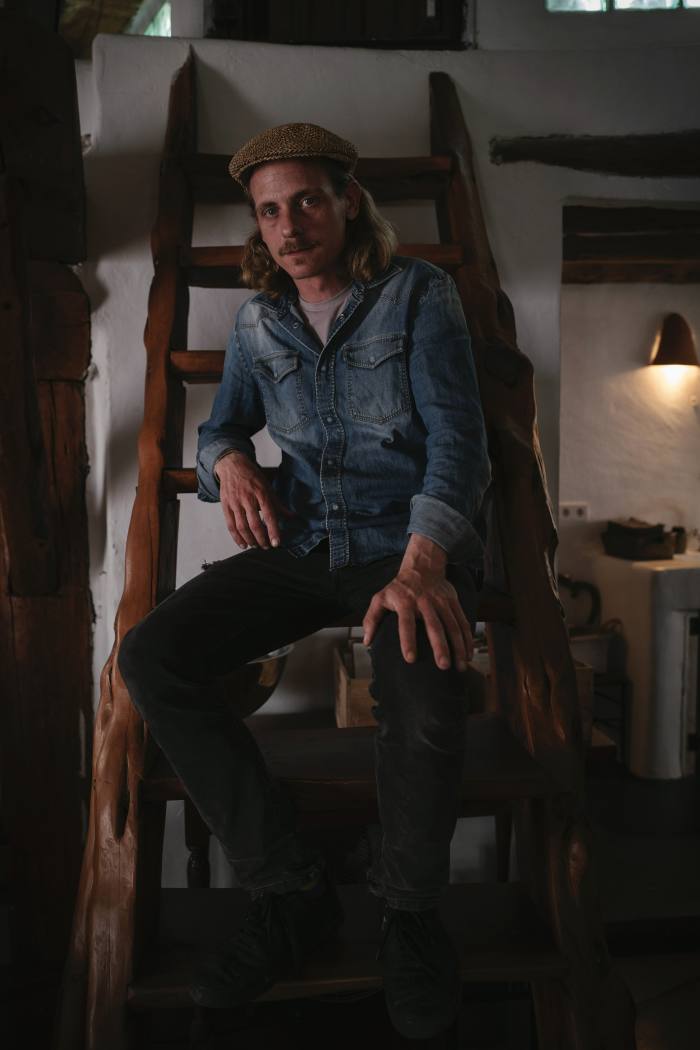
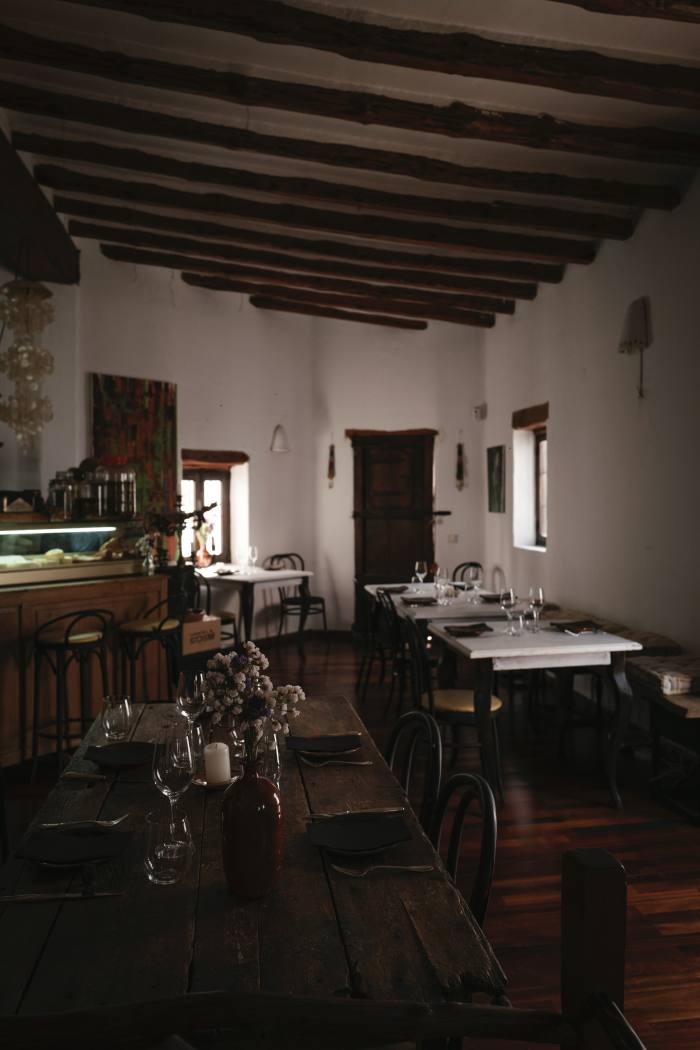
That night I’d booked a table at one of Serena Cook’s tips, Taller Sa Penya by Ibiza Food Studio, a diminutive restaurant in the scruffy former fishermen’s quarter of Sa Penya. Chef Boris Buono, a former colleague of René Redzepi at Noma in Copenhagen, calls it his “twisted international tapas bar”. Wearing his trademark floppy hat, Buono served me island-bred chicken with white asparagus and almonds, local red prawns with saffron allioli and a white wine called Hippie, from Formentera.
After dinner I moved on to Lola’s, a 1960s dance bar tucked under the great stone rampart, for old time’s sake and a large G&T. By one in the morning the place was just getting busy but half an hour later I was back at the Standard’s rooftop bar, gazing at the Dalt Vila skyline lit up and lovely. By 2am I was tucked up in bed — scandalously early by local standards but perhaps the new paradigm for a very different type of Ibiza weekend.
Details
Paul Richardson was a guest of The Standard Ibiza (standardhotels.com); double rooms from €225, the Castle Suite from €800. For Serena Cook’s concierge company see deliciouslysortedibiza.com; for more on visiting the island, see the tourist board website, ibiza.travel
Stay connected with us on social media platform for instant update click here to join our Twitter, & Facebook
We are now on Telegram. Click here to join our channel (@TechiUpdate) and stay updated with the latest Technology headlines.
For all the latest Travel News Click Here

